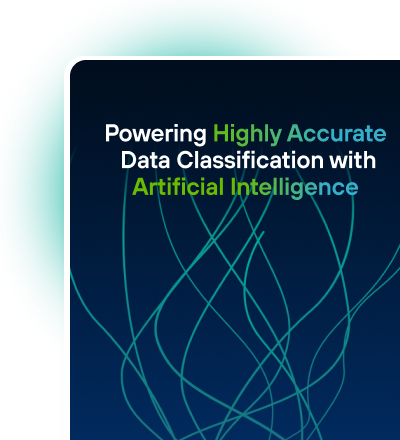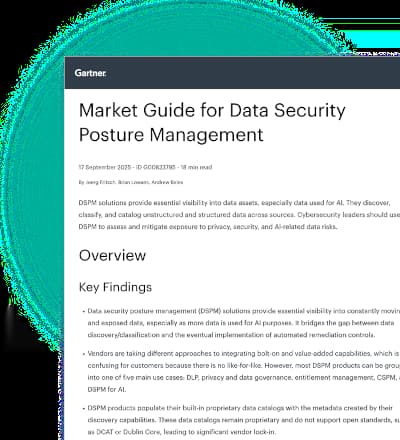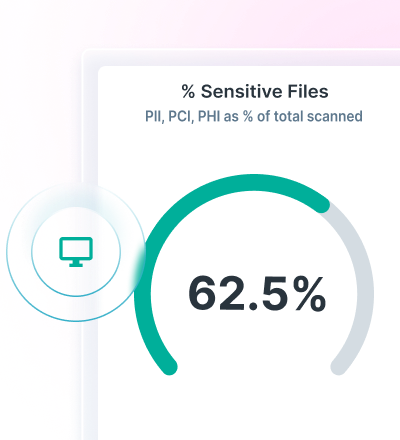Plus de 12 000 clients ne peuvent pas se tromper










































Trouvez et cataloguez les données dans l'ensemble de l'entreprise, et ce, à la vitesse de l'éclair.


Gartner®: Market Guide for Data Security Posture Management
In their first analysis of the new DSPM security category, Gartner® identifies the five main use cases, breaks down DSPM features and explores the requirements for securing GenAI.
Pourquoi Forcepoint Data Classification ?
Classifiez les données sur plusieurs sources et utilisez AI Mesh pour améliorer en permanence sa précision et son efficacité, ce qui permet aux entreprises de gagner un temps et des ressources précieux.
La couverture du plus large éventail de types de données du secteur permet de simplifier la conformité tout en fournissant une meilleure protection des données des entreprises.
AI Mesh classifie rapidement et avec précision les données en l'espace de millisecondes, simplifie les processus et réduit les efforts manuels pour permettre aux équipes de se concentrer sur les tâches à plus grande valeur ou les incidents plus importants.
Évitez les amendes coûteuses pour non-conformité grâce à des réglementations clés prêtes à l'emploi et à la couverture de types de données la plus large du secteur.

Sécurité des données partout où vous en avez besoin
Sécurisez vos données partout avec Forcepoint. Prévenez les violations, simplifiez la conformité, unifiez la gestion des politiques et adaptez-vous aux risques en temps réel grâce à nos solutions de sécurité des données.
Forcepoint DLP : protégez les informations sensibles et appliquez la conformité avec DLP Software-as-a-Service (SaaS).
DSPM (Gestion de la posture de sécurité des données) : automatisez la découverte, la classification et l'orchestration des données pour obtenir un contrôle et une visibilité totaux sur vos données dans l'ensemble de l'entreprise.
Protection adaptative aux risques : ajustez automatiquement les politiques en fonction du comportement de l'utilisateur pour vous adapter en temps réel aux risques émergents.
Questions les plus fréquemment posées
Qu'est-ce que Data Classification ?
Data Classification est la pratique consistant à étiqueter et à organiser les données dans des catégories prédéfinies, ce qui facilite la localisation et la récupération tout en garantissant un accès sécurisé aux utilisateurs autorisés.
Pourquoi Data Classification est-elle importante pour les entreprises ?
Les pratiques de Data Classification sont nécessaires pour maintenir une posture de sécurité solide. En vous assurant que les équipes de sécurité savent où trouver les informations sensibles et en mettant en place des règles déterminant qui est autorisé à y accéder, vous pouvez prévenir ou contenir les violations de données et garder les utilisateurs non autorisés éloignés des ressources auxquelles ils ne devraient pas avoir accès.
Quels sont les types de Data Classification ?
Classification basée sur le contenu : il s'agit de la pratique consistant à examiner les fichiers et à rechercher les informations sensibles qui s'y trouvent. Cela peut être utile si vous avez un problème lié aux informations qui ne sont pas destinées à la consommation publique et se cachant dans des types de fichiers apparemment inoffensifs.
Classification contextuelle : au lieu d'examiner directement le contenu des fichiers, cette approche examine principalement les métadonnées associées aux fichiers pour trouver des indices indiquant que les données à l'intérieur sont sensibles. Cela peut inclure l'identification de l'emplacement où un fichier est enregistré, de l'utilisateur qui l'a créé ou de l'application pour laquelle le fichier est conçu. Cette approche fonctionne bien lorsque votre base d'utilisateurs est bien formée et lorsque vous avez déjà un certain contrôle sur vos données sensibles.
Classification basée sur l'utilisateur : cela impose aux utilisateurs de passer au peigne fin les fichiers et de les catégoriser. Bien que cette approche puisse au mieux réduire de manière significative les faux positifs, elle repose non seulement sur une base d'utilisateurs hautement qualifiés, mais aussi sur le temps de classifier les données manuellement. Cela signifie qu'il ne convient généralement que pour les entreprises plus petites ou les petits ensembles de données.
Quelles sont les meilleures pratiques pour la mise en œuvre de Data Classification ?
Identification : découvrez où se trouvent vos données sensibles, y compris les référentiels cloud et les disques durs physiques, et prenez toutes les mesures immédiates nécessaires pour les sécuriser par chiffrement, contrôle d'accès physique, etc. Organisation : choisissez le processus que vous allez utiliser pour organiser les données en catégories. Formation : permettez aux employés de jouer un rôle dans l'étiquetage des données et leur placement au bon endroit en fonction de leur catégorie. Plus il y a de personnes ayant un rôle dans le processus, plus votre formation doit être rigoureuse pour vous assurer que l'erreur humaine ne compromet pas vos efforts.
Conformité : comprenez les réglementations applicables en matière de sécurité des données et de protection des données à vos opérations, ainsi que les sanctions en cas de non-conformité.
Solutions : trouvez la solution de Data Classification qui convient le mieux à votre entreprise. Dans de nombreux cas, il peut être préférable d'utiliser une plateforme de sécurité des données complète pouvant vous aider à la découverte, à la classification et à la hiérarchisation des données, plutôt que de regrouper différentes solutions de différents fournisseurs.
Data Classification peut-elle aider à la Conformité réglementaire ?
Oui, Forcepoint Data Classification peut aider à simplifier la conformité dans plus de 80 pays. Il vous aide à éviter les amendes coûteuses pour non-conformité, grâce à des réglementations clés prêt à l’emploi et à la couverture de types de données la plus large du secteur.
Quelle est la précision de Forcepoint Data Classification ?
Forcepoint Data Classification utilise la précision et l'efficacité de l'IA. Il aide à classifier les données sur plusieurs sources, grâce à la technologie AI Mesh, afin d'améliorer en permanence sa précision et son efficacité, ce qui permet aux entreprises d'économiser un temps et des ressources précieux.
Qu'est-ce qu'AI Mesh et comment est-il utilisé ?
Forcepoint Data Classification utilise AI Mesh pour fournir une Data Classification de grande précision. Son architecture d'IA en réseau repose sur un modèle de langage réduit et des composants d'IA avancés pour améliorer l'efficacité et réduire les faux positifs.











